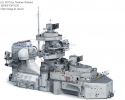The most widely used anti-aircraft gun of the Second World War
This photos are available in the shop. Click to go to the shop
The 40mm Bofors gun was designed in 1928 for the Swedish army and navy but by the mid-1930s it had earne a world-wide reputation for reliability and efficiency. It was adopted by the British Army in 1937 and a a licence to manufacture the weapon in the UK was obtained.
The Boforss accuracy and rapid rate of fire was particularly effective against low-flying or dive-bombing aircraft, making it a vital element in the air defence of Britain. Its lightness and robustness also allowed it to fulfil its role in the field with ground forces. It saw service with virtually every one of the combatant armies, in every theatre of the war.
This example is a 40mm Bofors Mark I gun on a Mark II mounting and a Mark I platform. From August 1940 until the end of the war it was part of a battery stationed at Sheerness, protecting London and the Medway towns from enemy aircraft approaching up the Thames Estuary.
Technical specifications:
CREW: Six
CALIBRE: 1.6 inches (40 mm)
WEIGHT: 1 ton 19 cwt (1,981 kg)
MAXIMUM CEILING: 23,600 feet (7193 m)
AMMUNITION: 2 lb (0,9 kg) high explosive








